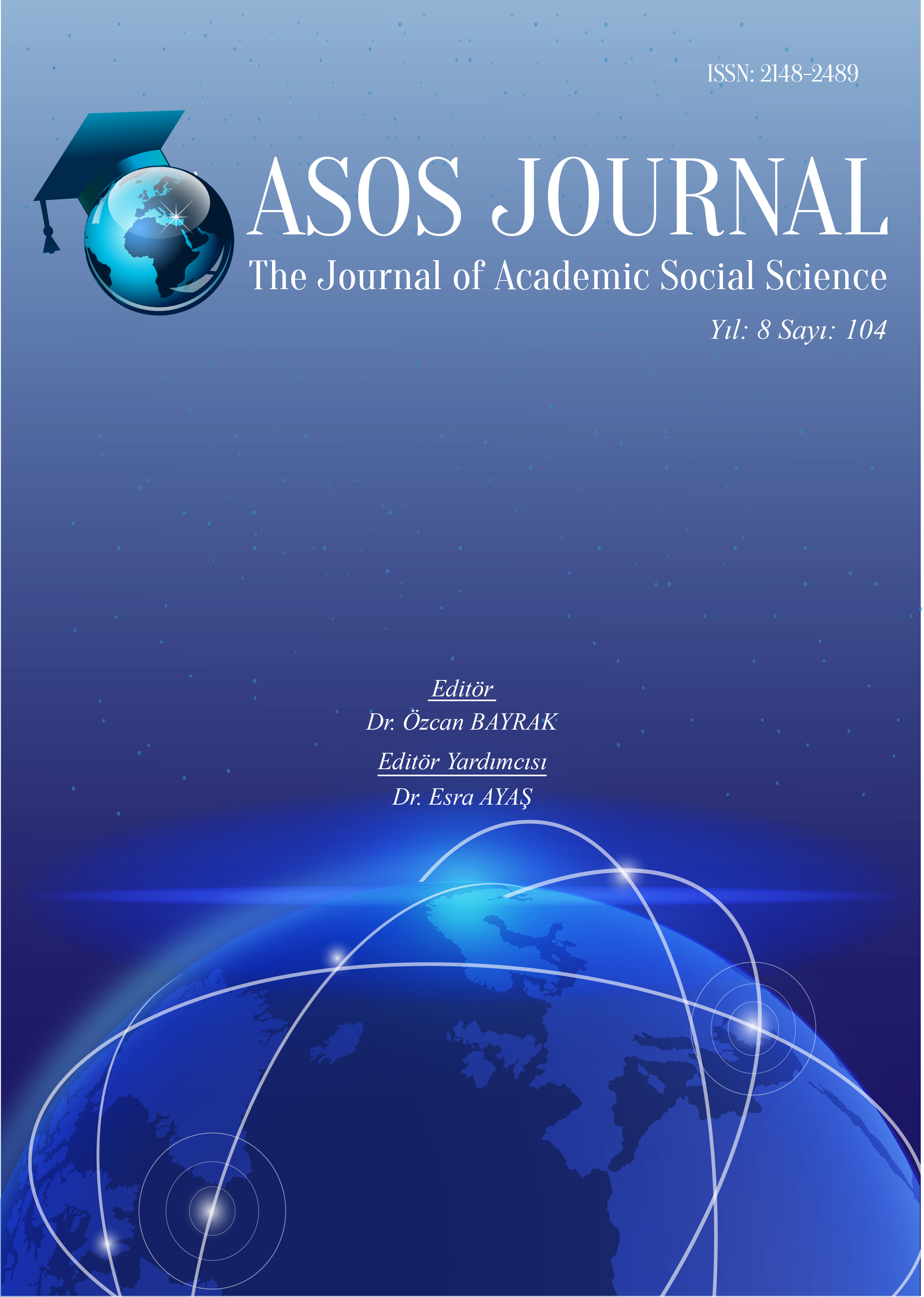Author :
Abstract
Bu çalışmada; Emevîlerde M.690 ile 740 tarihleri arasında sosyal, kültürel ve İslami ilimler alanlarında meydana gelen değişimler hakkında bilgiler verilmiştir. Bu değişimler; günlük yaşamda, sosyal ve kültürler alanlar ile dini ilimlerde kendini göstermiştir. Bu değişimlerin ana nedeni ise; fetih hareketleri sonucu elde edilen zenginlikler sayesinde ekonomi alanında yaşanan gelişmelerdir. Bu sayede, Emevî yöneticileri ile halkının sosyal ve kültürel yaşamlarında olumlu yönde ilerlemeler ortaya çıkmıştır. Daha önce sıradan bir yaşam sürdüren Emevîler, elde ettikleri zenginlik sayesinde, tarımsal faaliyetleri iyileştirmek amacıyla sulama kanalları açmış ve bataklıkları kurutarak ekilebilir arazileri genişletmişlerdir. Bununla birlikte; ekonomi alanında yaşanan gelişmelerden biri de, Abdulmelik b. Mervân’ın (M.685-705) İslam dünyasının ilk parasını bastırması olmuştur. Bu gelişme, Bizans parasını kullanan Emevîlerin kendi parasını kullanmasına olanak sağlamıştır. Bu sayede, Emevîler ekonomik özgürlüklerini elde etmişlerdir. Kültürel alanda ise; Fars ve Rumlarla karşılaşan Emevîler, bu iki milletin müzik kültüründen ve şarkıcılarından etkilenmiş ve onların kullandığı müzik aletlerini kullanmaya başlamışlardır. Mimari alanda ise; İslam sanat anlayışı ve mimarisinin esasları ortaya çıkmıştır. Şam’da inşa edilen Emevî Camisi ile Kudüs’teki Mescid-i Aksâ, İslam mimarisinin en güzel örnekleridir. Bununla birlikte; İslami ilimlerin temelleri atılmış Hadis, Kelâm, Tefsir gibi alanlarda önemli çalışmalar yapılmış ve bu çalışmalar İslami ilimlerin gelişmesine büyük katkı sağlamıştır.
Keywords
Abstract
In this study, informations about the changes in the social, cultural and Islamic sciences between A.D. 690 and 740 was given in the Umayyads. These changes are; It manifested itself in daily life, social and cultural fields, and religious sciences. The main reason for these changes is the developments in the field of economy thanks to the wealth obtained as a result of the conquest movements. In this way, positive advances have emerged in the social and cultural lives of Umayyad administrators and their people. The Umayyads, who previously lived an ordinary life, opened irrigation channels and expanded arable land by drying the marshes in order to improve agricultural activities thanks to the wealth they obtained. However, one of the developments in the field of economy is Abdulmelik b. Marwan (685-705 A.D.) was the suppression of the first money of the Islamic world. This development enabled the Umayyads who used Byzantine money to use their own money. In this way, Umayyads achieved their economic freedom. In the cultural field, the Umayyads, who encountered Persians and Greeks, were influenced by the music culture and singers of these two nations and started to use the musical instruments used by them. In the architectural field; The principles of Islamic art understanding and architecture have emerged. The Umayyad Mosque built in Damascus and Masjid al-Aqsa in Jerusalem are the best examples of Islamic architecture. In addition, important studies have been carried out in fields such as Hadith, Kalam and Tafsir, the foundations of which Islamic sciences have been laid and these studies have contributed greatly to the development of Islamic sciences.
Keywords
- Abdullah Mahmûd eş-Şehhâte, (1972), ‘‘Târîḫu’l-Ḳurʾân ve’t-tefsîr’’, Dâru’l- Fikri’l- ʿArabî, Kahire.
- Abdüşşafi Muhammed Abdüllatîf, (1984), ‘‘el-ʿÂlemu’l-İslâmî fi’l-ʿaṣri’l-Umevî’’, el- Matbaʿatu′l-Emiriyye, Kahire.
- Ali Hasan Abdülkādir (1965), ‘‘Naẓratun ʿâmme fî târîḫi’l fıḳhi’l İslâmî’’, Dâru’l- Fikri’l- ʿArabî, Kahire.
- Atvân, Hüseyin, (1986), ‘‘el-Fıraku’l-İslâmiyye fi Bilâdi’ş-Şâm fi’l-Asri’l Emevî’’, Darul Cil, Beyrut.
- Birekul, Mehmet; Yılmaz, Fatih Mehmet, (2001), ‘‘Peygamber Günlerinde Sosyal Hayat ve Aile’’ , Yediveren Yayınları, Konya.
- Creswell, Keppel Archibald Cameron, (1968), ‘‘Early Muslim Architecture’’ , Librairie Du Liban, Beirut.
- Çağatay, Neşet, (1982), ‘‘İslam Öncesi Arap Tarihi ve Cahiliye Çağı’’, Ankara Üniversitesi İlahiyat Fakültesi yayınları, Ankara.
- Çelebi, Ahmed, (1976), ‘‘İslâmda Eğitim-Öğretim Târihi,’’ (çev. A.Yardım), Damla Yayınevi, İstanbul.
- Ebû Bekir ez-Zübeydî, (1954), ‘‘Ṭabaḳātu’n-naḥviyyîn ve’l-luġaviyyîn’’, (nşr. M. Ebü’l-Fazl), el-Matbaʿatu′l-Emiriyye, Kahire.
- el-Âbidi, Salah Hüseyin, (1980), ‘‘el-Melabisu’l-Arabiyye’’, Bağdat.
- el-‘Azm, Useyme, (1996), ‘‘el-Muctema’ fi’l –‘asri’l-Umevi’’ , Dâru Ṣâdır, Beyrut.
- el-Belâzurî, Ahmed b. Yahya b. Cabir. (1987), ‘‘Futûḥ’’ , (Nşr. A.Enis), Daru’l-Kutubi’l- ʿİlmiyye. Beyrut: c. I-IV.
- el-İsfahânî, Ebu’l-Ferec Ali b. el- Huseyn, (1985), ‘‘el-Ağânî’’, Dâru’l-kutub, Bulak, c.5 -9.
- ez-Zebidi, Zeyni’d-din Ahmet b.Abdi’l-Latif, (1973), Sahih-i Buhârî Muhtasarı Tecridi Sarih Tercümesi, ‘‘Kitabu’l-Libas’’ , (çev. K. Miras) Türk Tarih Kurumu Basımevi, Ankara.
- Hitti, Philip Khuri, (1980), ‘‘Siyasi ve Kültürel İslam Tarihi’’, (çev. S. Tuğ), Boğaziçi Yayınla- rı, İstanbul, c.2.
- İbnu’l-Esîr, Ebu’l-Hasen İzzuddîn Alî b. Muhammed b. Muhammed eş-Şeybânî el-Cezerî, (1987), ‘‘el-Kâmil fi't-târîḫ,’’ (III-V). (Thk. Abdullah el-Kadi), Mektebetu’n-Nahdati’lʿArabiyye, Beyrut.
- İbn Kesîr, İmâduddîn Ebu'l-Fidâ İsmail İbn Ömer, (1995), ‘‘el-Bidaye ve’n-Nihaye,’’ (çev. M. Keskin), Çağrı Yayınları, İstanbul, c. 8-13.
- İbn Ebû Şeybe, (1989), ‘‘el-Muṣannef,’’ (Nşr. Kemâl Yûsuf el-Hût), Daru’l-Kutubi’l- ʿİlmiyye,
- Kılıçlı, Mustafa, (1993), ‘‘Sadru’l İslam ve Emevîler Devrinde Gınâ’’, Atatürk Üniversitesi Fen-Edebiyat Fakültesi Yayınları, Erzurum.
- Koçyiğit, Talat, (1977), ‘‘Hadîs Tarihi’’ Ankara Üniversitesi Basımevi, Ankara.
- Mazaherî, Ali, (1972), ‘‘Ortaçağda Müslümanların Yaşayışları’’ , (çev. B. Üçok) İlke Yayınları,
- Mez, Adam, (2000), ‘‘10 yüzyılda İslam Medeniyeti’’ (çev.S. Şaban) İnsan Yayınları, İstanbul.
- Turabi, Ahmet Hakkı, (2017), ‘‘İlk Dönem İslâm Dünyası’nda Mûsikî Çalışmaları’’, Türk Din Mûsikîsi, Grafiker Yayınları, Ankara.
- Yıldız, Hakkı Dursun, (1986), ‘‘Doğuştan Günümüze İslam Tarihi’’, Hulefây-ı Raşidin ve Emeviler, Çağ Yayınları, İstanbul, c.2.
- Zeydan, Corci, (1973), ‘‘İslam Medeniyetleri Tarihi’’, (çev. Z. Meğamiz ), Üçdal Neşriyat, İs- tanbul, c.2.





